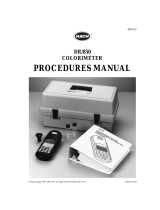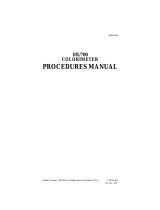
16
The battery icon will show no bars and flash when the unit first turns on. Then the
indicator will indicate the battery status by showing 0, 1, 2, 3, or 4 bars. It will take
6 hours to fully charge a low battery. The battery icon will flash when the battery
is charging. The battery icon will show four bars and stop flashing when it is fully
charged. The charging circuit will automatically switch to a float charge when the
battery is fully charged. The charger may remain connected. Some computers will
NOT supply power to their USB ports during standby operation. The wall adapter will
charge the unit continuously. Storing the meter above ambient room temperature
will decrease the battery charge more quickly than storage at room temperature.
If the meter does not turn on, it means that the battery is at a very low charge.
Charging the battery with the wall adapter in this state may take up to 10 hours. At
low temperatures, approaching 0 °C, the battery will charge more slowly. It will not
charge at all below 0 °C.
The battery icon will show no bars and continuously flash if the battery is getting
low but the unit will still operate normally. A “Low Battery” message on the status
bar of the display will replace the time when the battery voltage is too low for
proper operation and accuracy may be degraded. A “Shutdown Low Batt” message
on the display will appear for a few seconds before the power is switched off when
the battery is too low to operate the unit. When the battery icon simultaneously
flashes bars 1 and 2 followed by bars 3 and 4, it is an indication that the battery is
damaged and technical support should be contacted.
To extend the life of the battery:
• Shut down the unit with the power switch when not taking measurements
or use the power save option to have the unit automatically turn off after 5
minutes.
• Store the unit at a moderate temperature.
• Fully charge the battery before storing the unit for extended periods of time.
• Fully charge the battery at least once per year. Failure to do so may result in a
permanently drained battery.
• Limit backlight use. The unit consumes three times the normal power when the
backlight is on. Set the backlight time option to 10 seconds or select “Button
Control” and keep the backlight off.
BATTERY REPLACEMENT
The lithium ion battery used in this unit should last for many years with normal
use. When it no longer powers the unit long enough to meet testing requirements
it should be replaced. Contact LaMotte Company by phone (1-800-344-3100) or
MAINTENANCE
CLEANING
Clean the exterior housing with a damp, lint-free cloth. Do not allow water to enter
the light chamber or any other parts of the meter. To clean the light chamber and
optics area, point a can of compressed air into the light chamber and blow the
pressurized air into the light chamber. Use a cotton swab dampened with Windex®
window cleaner to gently swab the interior of the chamber. Do not use alcohol; it
will leave a thin residue over the optics when dry.



























